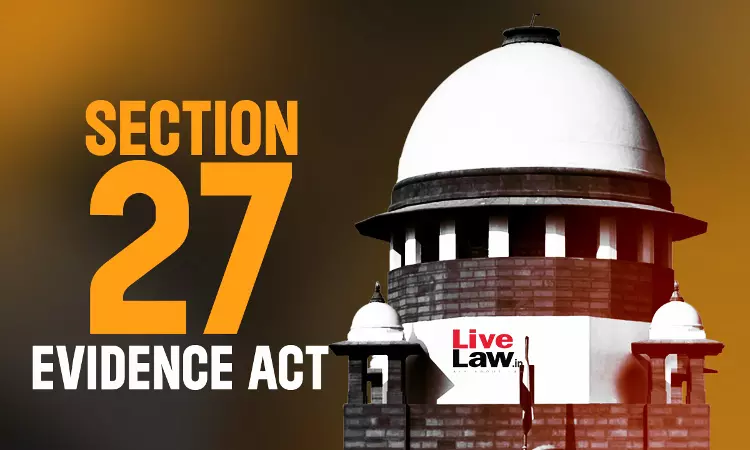S. 27 Evidence Act | Simultaneous Disclosure Statements Made By Multiple Accused Need Greater Scrutiny: Supreme Court
Yash Mittal
22 Sept 2025 6:08 PM IST

The Supreme Court on Monday (Sep. 22) observed that for joint disclosure statements, made by multiple accused simultaneously, to become admissible under Section 27 of the Evidence Act, high scrutiny is needed to rule out the possibilities of tutoring of the accused.
The Court added that while simultaneous disclosure statements can be legally admissible, courts must exercise heightened caution, and the prosecution bears the burden of proving that the disclosures were genuine, independent, and corroborated by other evidence.
“While asserting that a joint or simultaneous disclosure would per se be not inadmissible under Section 27, it was observed that it is very difficult to place reliance on such an utterance in chorus; which was also held to be, in fact, a myth. Recognising that there would be practical difficulty in placing reliance on such evidence, it was declared that it is for the Courts to decide, on a proper evaluation of evidence, whether and to what extent such a simultaneous disclosure could be relied upon.”, the Court said relying on Kishore Bhadke v. State of Maharashtra, (2017) 3 SCC 760.,
The Court noted that in Kishore Bhadke that simultaneous statements were admitted only because "the information given by one, after the other, was without any break, almost simultaneously and such information was followed up by pointing out the material thing by both the accused, in which circumstance it was held that there is no reason to eschew such evidence.”,
A bench of Justice KV Viswanathan and Justice K Vinod Chandran set aside the conviction of three individuals in a case over the murder of a Karnataka based police constable, after noting that a simultaneous disclosure statements were made by two accused, but the Investigating Officer failed to clarify whether the disclosures by the accused were sequential or simultaneous, undermining the credibility of the recovery of murder weapon. Moreover, the independent witnesses turned hostile, and forensic links were absent, leading the Court to observe that the prosecution failed to discharge the proof beyond a reasonable doubt.
A key piece of evidence was the recovery of a murder weapon (a chopper) at the instance of A4. However, the Investigating Officer testified that both A3 and A4 had made disclosure statements about the weapon's location. The Court found this evidence "sketchy" and unreliable, citing Kishore Bhadke (supra).
“The fact that confessions were made by both the accused and the recovery was made from one of the accused, A4, leading the police to the spot would restrain us from treating the recovery as an inculpating circumstance against A3 or A4, especially when the confession is taken simultaneously from both the accused. We are of the opinion that in the present case there can be no reliance placed on the recovery based on the sketchy evidence adduced.”, the judgment authored by Justice Chandran observed.
The Court also reiterated that confession to police officers are not admissible in evidence. The prosecution's case rested wholly on circumstantial evidence, but the chain of circumstances was incomplete.
Motive, recovery, and alleged presence of body in house of accused were not proved beyond reasonable doubt. Suspicion about genesis and origin of crime further created reasonable doubt.
Accordingly, the appeal was allowed, and the conviction was set aside.
Cause Title: Nagamma @ Nagarathna & Ors. Versus The State of Karnataka
Citation : 2025 LiveLaw (SC) 930
Click here to read/download the judgment
Appearance:
For Appellant(s) : Mr. C.B. Gururaj, Adv. Mr. Prakash Ranjan Nayak, AOR
For Respondent(s) : Mr. Nishanth Patil, A.A.G. Mr. Sanchit Garga, AOR Mr. Arijit Dey, Adv. Mr. Awanish Gupta, Adv.


